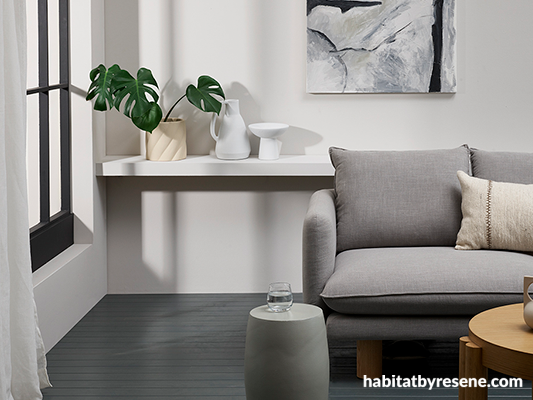
Think wood stains are immune to influence from colour trends? Think again
11 Nov 2024
Beloved for their classic and earthy appeal, wood stains remain an essential tool in the world of design as a method for enhance the natural beauty of timber while complementing a range of aesthetics. But despite their timeless appeal, wood stains are not immune to the ebb and flow of colour trends. Today’s wood stain trends reflect a strong preference for natural tones both indoors and out. From cool blonde tones to warm honey hues, walnut browns, rich cedar and black, the most popular selection of Resene wood stain colours being used today are prized for the depth and character they bring to all sorts of projects and applications. By selecting the right Resene wood stain colours, products and finishes, you can elevate the appearance of wood stains and create spaces that feel inviting, grounded and timeless for your clients while maintaining the integrity of the material so that it can be enjoyed for many years to come.
Below, we delve into the current trends in wood stain colours for both interior and exterior applications, highlighting popular hues, recommended applications and the ideal Resene paint colours that will complement a variety of different looks.
Light blonde and honey hues remain top interior wood stain trends
When it comes to interior wood stains, arguably the biggest influence for which colours become top trends is furniture – and today’s most popular colours are taking cues from broader trends towards organic minimalism and Scandinavian-inspired design. In turn, light coloured stains in cool blonde tones, golden honey hues and even pale caramel shades are being preferred for the airy levity they evoke. Paler stain colours like Resene Colorwood Natural and Resene Colorwood Rock Salt are top choices for timber floor and furniture, however, they are also hugely popular for wood clad walls and ceilings as a way of bringing warmth and texture to indoor spaces.
When considering paint colours pairings, team these subtle stain colours with soft, neutral tones that highlight their warm or cool undertones. A soft, warm linen beige like Resene Half Haystack complements the golden undertones of honey stains like Resene Colorwood Natural while a muted green like Resene Aspiring provides an earthy contrast to a cooler blonde tone like Resene Colorwood Rock Salt, enhancing the organic feel. For Scandi-inspired spaces, you can’t go wrong with classic creams or off-whites such as Resene Half Thorndon Cream and Resene Blanc, which pair beautifully with light neutral wood stains while keeping the space fresh and airy.

Top tip: Keep in mind that different types of timber have their own natural tone that is inherent to the wood itself so paler and subtler wood stain colours generally work best on lighter coloured woods such as pine, ply or oak.
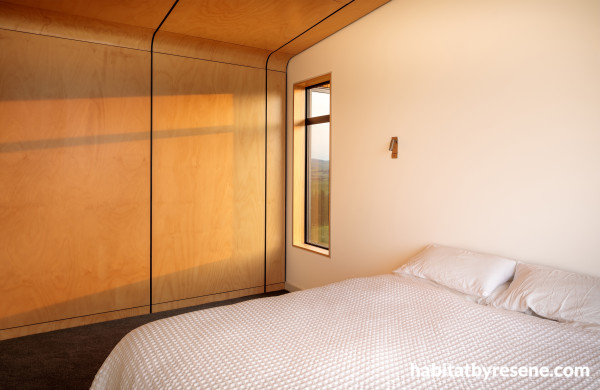
Interior plywood wall and ceiling stained in Resene Colorwood Natural and finished in Resene Aquaclear satin, plasterboard wall painted in Resene SpaceCote Low Sheen waterborne enamel tinted to Resene Alabaster. Project by Totem Studio Architects, image by John Foster.
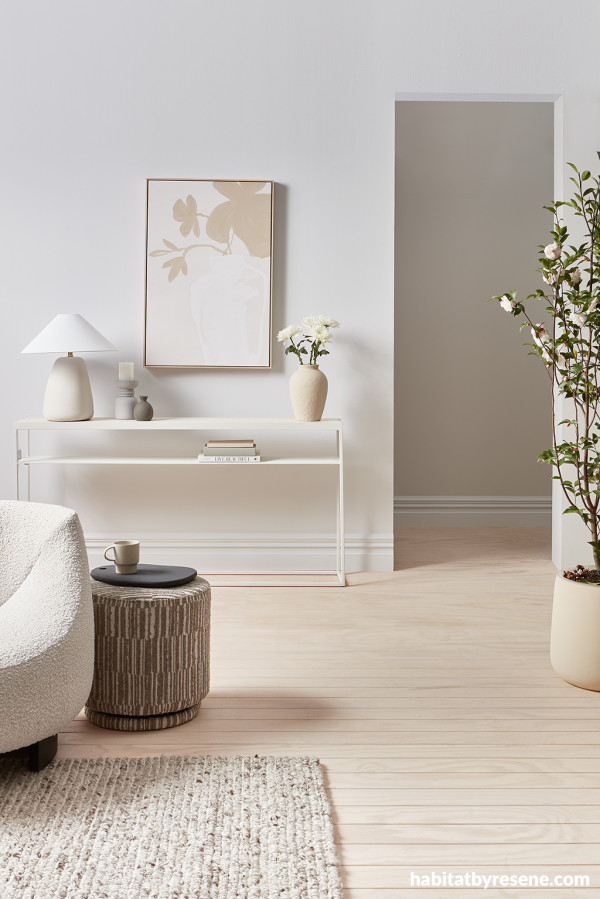
Wall painted in Resene White Thunder, hallway wall in Resene Flotsam, floor finished in Resene Colorwood Becalm, skirting boards in Resene Alabaster, plant pot and vase in Resene Tua Tua, candleholder in Resene Half Jumbo, small vase in Resene Greige and tray in Resene Invincible. Console, sofa, lamp and ottoman from Soren Liv, artwork and cup from A&C Homestore, rug from Baya.
Medium and darker tones gain momentum indoors
While light tones remain popular indoors, there has recently been a notable shift towards medium and darker stains that emphasise richness and timeless elegance. Rich, dark browns with subtle hints of mocha or espresso tones such as Resene Colorwood Deep Oak and Resene Colorwood English Walnut are popular for those seeking a dramatic look while warm mid-tone colours like Resene Colorwood Walnut and Resene Colorwood Mahogany are perfect for highlighting grain patterns on woods like walnut and mahogany for a sophisticated, modern appeal or in spaces that feature mid-century modern furnishings. In addition to flooring, where darker tones are useful for anchoring a space, deeper toned wood stains are being increasingly used on cabinetry and accent furniture like coffee tables and sideboards – lending these pieces a refined and striking presence.

Darker stains like Resene Colorwood Crowshead and Resene Colorwood Dark Ebony pair well with richer, dramatic paint colours that complement their depth. Smoky charcoals or deep slate greys like Resene Baltic Sea or Resene Big Stone are sophisticated pairings for flooring and furniture in dark wood stains like Resene Colorwood Treehouse or Resene Colorwood Iroko while a muted gold like Resene Tussock brings a warm and luxurious ambiance. Alternatively, a subdued dusty blue like Resene Longitude or a fleecy white like Resene Merino can add much needed softness to interior spaces that feature the dark wood in Resene Colorwood Bark for a clean and classic aesthetic.


Top tip: To change or enhance the look of previously stained timber without having to sand the wood’s surface back to bare, many Resene interior clear coats can be tinted with Resene Colour Enhance – which is available in a range of colours.

Walls painted in Resene Flotsam, window frame in Resene Invincible, floor finished in Resene Colorwood Shade, stool in Resene Half Jumbo with Resene FX Pearl Shimmer applied on top, vases in Resene Tua Tua and Resene White Thunder and hand-painted artwork in Resene White Thunder, Resene Greige, Resene Flotsam and Resene Invincible. Sofa and coffee table from Soren Liv, cushion from A&C Homestore.
Colour washes continue to be popular for coastal looks
Colour washes – particularly whitewashes and greywashes – continue to be popular finishes for timber surfaces in interiors with beachy boho or classic coastal vibes. Resene Colorwood Whitewash, Resene Colorwood Light Greywash and Resene Colorwood Mid Greywash bring a weathered driftwood-like finish and work especially well on furniture or accent walls, where they add texture without overwhelming. Greywash finishes are frequently used on shiplap or reclaimed wood paneling, adding texture and modern rustic appeal. Being lighter in tone, these colour washes work best with equally breezy, coastal-inspired shades. A soft sandy beige like Resene Quarter Canterbury Clay is an elegant complement for timber in Resene Colorwood Mid Greywash and helps enhances its beachy feel. A crisp white like Resene Sea Fog makes greywashed wood pop, ideal for coastal or Scandi-inspired styles. Where more depth of colour is needed, grey greens, greyed blues and cloud greys like Resene Half Inside Back, Resene Duck Egg Blue and Resene Midwinter Mist are easy breezy options for enhancing classic coastal or Hamptons-inspired aesthetics.

While neutral tones are among the most popular colour wash finishes, there has also been a move to embrace chromatic colour washes. Options like Resene Colorwood Becalm, which has a slightly rosy tone, and Resene Colorwood Rising Tide, which includes green and blue pigmentation, are interesting alternatives to neutrals when creating a monochromatic colour scheme. Look to the Resene We Speak Beach palette for other chromatic colour wash options.
Top tip: Try a clear coat with a satin finish over whitewashed or greywashed timber to add protection without detracting from the weathered effect.
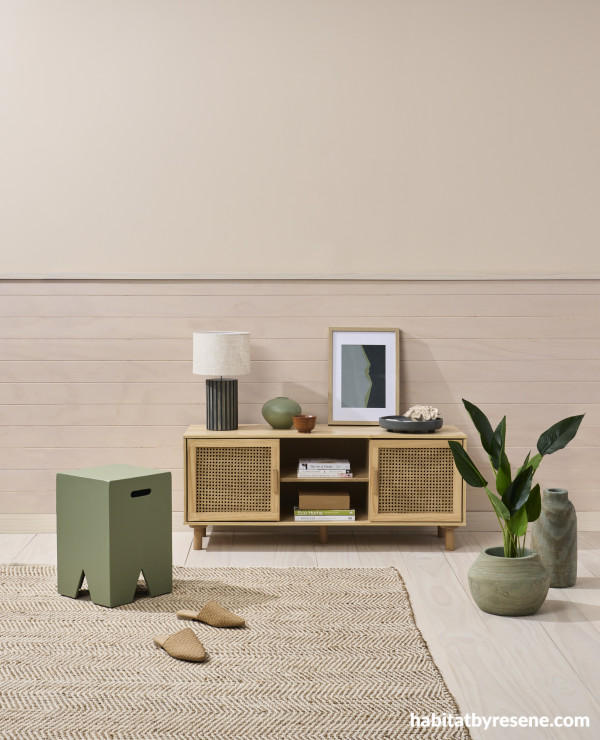
Wall painted in Resene Bone with tongue-and-groove panelling finished in Resene Colorwood Becalm, floor in Resene Colorwood Breathe Easy, sideboard in Resene Colorwood Bask, lamp and low platter in Resene Colorwood Shade, wooden plant pot and vase (on floor) in Resene Colorwood Shore Thing (left) and Resene Rising Tide (right), stool and painted vase (on sideboard) in Resene Paddock, faux coral in Resene Bone, painted book in Resene Brown Sugar and DIY artwork in Resene Rolling Stone, Resene Paddock and Resene Mine Shaft.
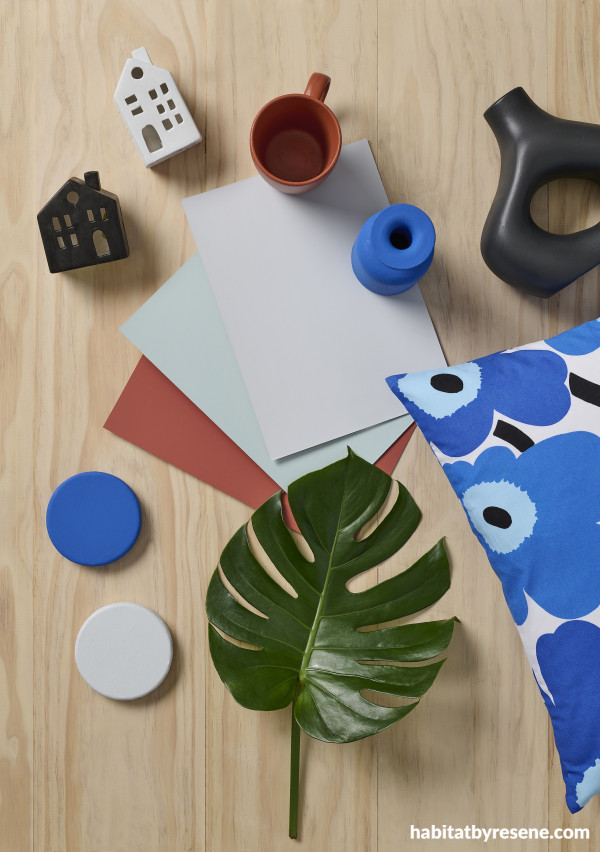
Timber background finished in Resene Colorwood Whitewash with A4 drawdown paint swatches in (from left to right) Resene Hot August, Resene Jet Stream and Resene Half Resolution Blue, coasters in Resene Half Resolution Blue (top) and Resene Duck Egg Blue (bottom), cup in Resene Hot August, blue vase in Resene Half Resolution Blue, black vase in Resene Nero and house ornaments in Resene Nero (left) and Resene Alabaster (right). Cushion from Bolt of Cloth.
Natural and black stain options continue to rule outdoors
For exteriors, wood stain colours often hinge on the style of a project’s exterior hues. Certain colours seem to be far more preferable for traditional-building styles while other choices dominate contemporary forms. But regardless of the building’s style, most of us look to wood stains that harmonise with the natural landscape to create a cohesive outdoor aesthetic that integrates seamlessly with the surrounding environment.
As more and more clients have been requesting a ‘natural’ look for their exterior wood surfaces, designers are looking to the Resene stain colours that most closely resemble their timber’s inherent hue. This strategy for staining offers the most untouched look while ensuring that the material is adequately protected from the elements. It’s important to note that Resene does not recommend applying a clear coat only to exterior timber as a clear coat alone does not provide the substrate with much-needed protection from harmful UV light.
While colour choices for a ‘natural’ look can vary significantly depending on what type of wood has been used for a project’s exterior, cedar tones have been making a comeback, prized for their rich, reddish-brown hue that adds warmth and vibrancy. Stains like Resene Woodsman Cedar and Resene Woodsman Meranti are popular for cladding, decking, fences and pergolas as the red undertones provide a beautiful complementary contrast with greenery. Pair cedar stains with warm, nature-inspired paint colours to complement its rich tones. A blackened green such as Resene Black Forest complements the reddish tones of cedar and harmonising with landscaping, a muted terracotta like Resene Crail enhances cedar’s vibrancy while a neutral taupe like Resene Quarter Malta offers soft, elegant contrast.

Top tip: Remember that any timber surfaces that are part of your project design should be easily accessible for your client to be able to keep up with their maintenance. Stained and colourwashed timber that’s out of reach can cause additional headaches and add financial burdens if special equipment or scaffolding needs to be hired regularly. These inconveniences could potentially put the integrity of your client’s investment at risk and detract from the look of your design if upkeep isn’t feasible.
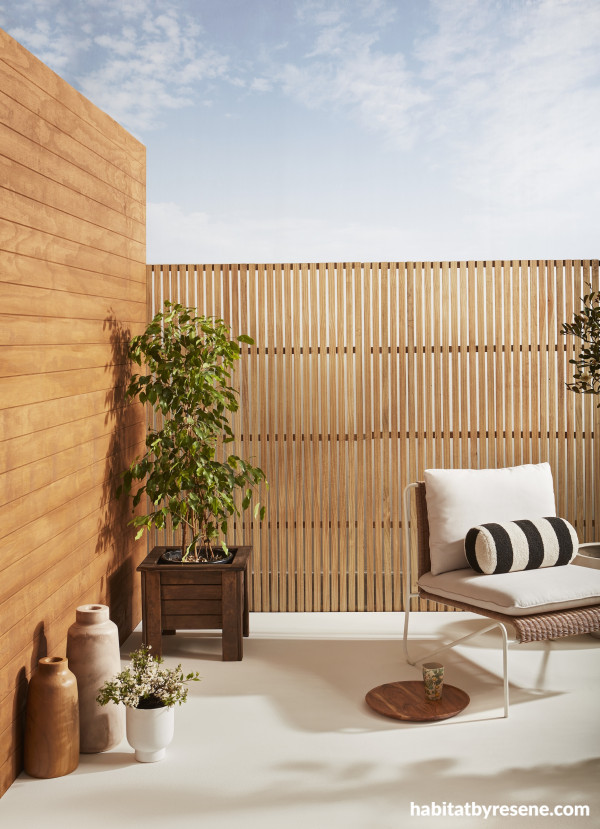
Timber weatherboards (left) finished in Resene Woodsman Cedar Natural Wood Oil Egmont, screen finished in Resene Woodsman Cedar Natural Wood Oil Aorangi, patio floor painted in Resene Walk-on tinted to Resene Merino, vases in Resene Woodsman Cedar Natural Wood Oil Hanmer (left) and Resene Woodsman Cedar Natural Wood Oil Aotea (right), planter box in Resene Woodsman Cedar Natural Wood Oil Mount Aspiring, tray finished in Resene Woodsman Cedar Natural Wood Oil Nelson Lakes and small plant pot in Resene Lumbersider Low Sheen tinted to Resene Merino. Chair from Soren Liv.
For projects with contemporary silhouettes, charcoal and ebony stains like Resene Woodsman Dark Ebony and Resene Woodsman Pitch Black offer a bold, modern aesthetic. These colours are commonly used on exterior walls and fences to provide striking contrast against lush landscaping contrasted with decking in warm wood tones like Resene Woodsman Oregon. On surfaces where a black tone is preferred but more visible wood grain is desired, opt for Resene Woodsman Charred Black – which provides a sheerer look than Resene Woodsman Pitch Black. These deep stains pair best with crisp and bold colours. For a refreshing update to a traditional-style home, try crisp white trims in Resene White Pointer to contrast sharply against a deeper stain like Resene Woodsman Crowshead. A warm beige like Resene Alpaca can soften a charcoal stain like Resene Woodsman Tiri for a more balanced feel while a deep green like can add drama while still blending well with natural surroundings.

Top tip: When using dark paint or wood stain colours outdoors, always ask for a Resene CoolColour formula. Resene CoolColours look like normal colours but, thanks to innovative pigment technology, they reflect back more of the sun’s harmful UV radiation to keep the surface and substrate from absorbing damaging heat.
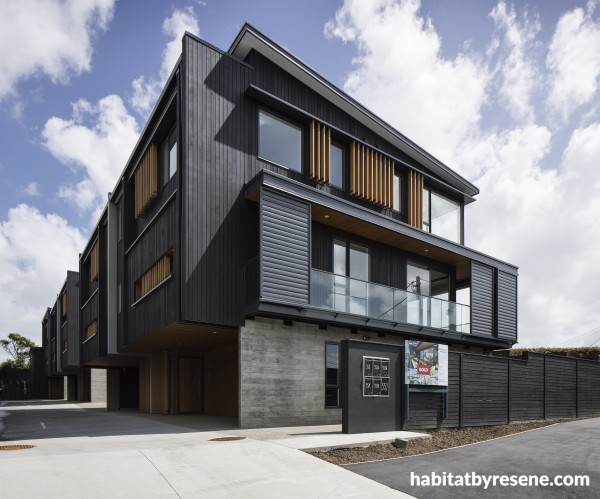
This home, designed by JWA Architects, is stained in Resene Woodsman Pitch Black timber stain with Resene Woodsman Natural timber stain used for contrast on the vertical solar shades and the soffits beneath the awning. Image by Simon Devitt
Lastly, greywashes also continue to be a popular option for exterior surfaces in coastal settings. For these projects, Resene Woodsman Mid Greywash is ideal for cladding, fences or garden structures like pergolas, arbours and gazebos to give surfaces a weathered look without sacrificing the integrity of the timber to damage from the elements. Pair greywashed timber with cool, understated colours for a cohesive, natural look. A cool soft blue like Resene Breeze adds a refreshing contrast and complements the grey. Resene Silver Chalice can be used for a classic grey-on-grey palette which enhances the subdued charm of greywashed timber. Or a soft mossy green like Resene Bud is perfect for blending with the landscape.


Exterior weatherboard cladding finished in Resene Woodsman Whitewash with trims painted in Resene Lumbersider Low Sheen tinted to Resene Double Sea Fog. Project by Strachan Group Architects, image by Simon Devitt.
For an in-depth colour trend forecast that looks at all the major Resene paint colours, wood stains and wallpapers that are set to dominate over the coming months, check out the latest issue of BlackWhite magazine.
projects Amber Armitage, Laura Lynn Johnston
images Bryce Carleton, Wendy Fenwick
Published: 11 Nov 2024






